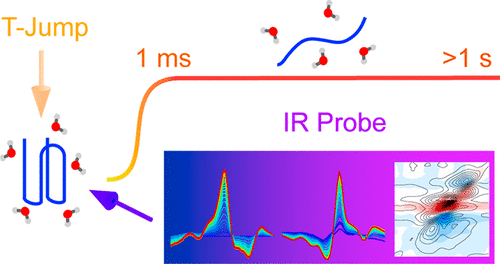当前位置:
X-MOL 学术
›
J. Phys. Chem. B
›
论文详情
Our official English website, www.x-mol.net, welcomes your
feedback! (Note: you will need to create a separate account there.)
Temperature-Jump 2D IR Spectroscopy with Intensity-Modulated CW Optical Heating.
The Journal of Physical Chemistry B ( IF 2.8 ) Pub Date : 2020-09-09 , DOI: 10.1021/acs.jpcb.0c07177 Brennan Ashwood 1 , Nicholas H C Lewis 1 , Paul J Sanstead 1 , Andrei Tokmakoff 1
The Journal of Physical Chemistry B ( IF 2.8 ) Pub Date : 2020-09-09 , DOI: 10.1021/acs.jpcb.0c07177 Brennan Ashwood 1 , Nicholas H C Lewis 1 , Paul J Sanstead 1 , Andrei Tokmakoff 1
Affiliation

|
Pulsed temperature-jump (T-jump) spectroscopy with infrared (IR) detection has been widely used to study biophysical processes occurring from nanoseconds to ∼1 ms with structural sensitivity. However, many systems exhibit structural dynamics on time scales longer than the millisecond barrier that is set by the time scale for thermal relaxation of the sample. We developed a linear and nonlinear infrared spectrometer coupled to an intensity-modulated continuous wave (CW) laser to probe T-jump-initiated chemical reactions from <1 ms to seconds. Time-dependent modulation of the CW laser leads to a <1 ms heating time as well as a constant final temperature (±3%) for the duration of the heating time. Temperature changes of up to 75 °C in D2O are demonstrated, allowing for nonequilibrium measurements inaccessible to standard pulsed optical T-jump setups. T-jump linear absorption, pump–probe, and two-dimensional IR (2D IR) spectroscopy are applied to the unfolding and refolding of ubiquitin and a model intercalated motif (i-motif) DNA sequence, and analysis of the observed signals is used to demonstrate the limits and utility of each method. Overall, the ability to probe temperature-induced chemical processes from <1 ms to many seconds with 2D IR spectroscopy provides multiple new avenues for time-dependent spectroscopy in chemistry and biophysics.
中文翻译:

具有强度调制连续波光学加热的温跃二维红外光谱。
具有红外 (IR) 检测的脉冲温度跳跃 (T-jump) 光谱已被广泛用于研究从纳秒到约 1 ms 发生的具有结构敏感性的生物物理过程。然而,许多系统在时间尺度上表现出结构动力学,其时间尺度长于由样品热弛豫时间尺度设置的毫秒屏障。我们开发了一种与强度调制连续波 (CW) 激光器耦合的线性和非线性红外光谱仪,以探测 T 跳跃引发的化学反应,从 <1 毫秒到几秒。CW 激光器的时间相关调制导致 <1 ms 加热时间以及在加热时间持续时间内恒定的最终温度 (±3%)。D 2 中温度变化高达 75 °CO 被证明,允许进行标准脉冲光学 T 跳设置无法进行的非平衡测量。T 跳跃线性吸收、泵浦探针和二维红外 (2D IR) 光谱应用于泛素和模型插入基序 (i-motif) DNA 序列的展开和重折叠,并对观察到的信号进行分析证明每种方法的局限性和实用性。总体而言,使用二维红外光谱探测温度诱导的化学过程从 <1 毫秒到几秒的能力为化学和生物物理学中的时间相关光谱提供了多种新途径。
更新日期:2020-10-02
中文翻译:

具有强度调制连续波光学加热的温跃二维红外光谱。
具有红外 (IR) 检测的脉冲温度跳跃 (T-jump) 光谱已被广泛用于研究从纳秒到约 1 ms 发生的具有结构敏感性的生物物理过程。然而,许多系统在时间尺度上表现出结构动力学,其时间尺度长于由样品热弛豫时间尺度设置的毫秒屏障。我们开发了一种与强度调制连续波 (CW) 激光器耦合的线性和非线性红外光谱仪,以探测 T 跳跃引发的化学反应,从 <1 毫秒到几秒。CW 激光器的时间相关调制导致 <1 ms 加热时间以及在加热时间持续时间内恒定的最终温度 (±3%)。D 2 中温度变化高达 75 °CO 被证明,允许进行标准脉冲光学 T 跳设置无法进行的非平衡测量。T 跳跃线性吸收、泵浦探针和二维红外 (2D IR) 光谱应用于泛素和模型插入基序 (i-motif) DNA 序列的展开和重折叠,并对观察到的信号进行分析证明每种方法的局限性和实用性。总体而言,使用二维红外光谱探测温度诱导的化学过程从 <1 毫秒到几秒的能力为化学和生物物理学中的时间相关光谱提供了多种新途径。













































 京公网安备 11010802027423号
京公网安备 11010802027423号